Transportation is a spatial activity. The geographic Information System (GIS) is the process of capturing, managing, analyzing, and presenting spatial data. GIS techniques are essential to the study of various aspects of transportation. In this entry, the state of knowledge regarding atomized transportation modes is presented. Atomized transportation modes are defined as transportation modes which deal with low passenger numbers.
- GIS
- spatial analysis
- active transportation
- micromobility
- cars
- Introduction
The spatial aspect of transportation is crucial, as mobility is governed by space. Transportation modes encompass a spectrum that ranges from atomization—transportation modes that deal with the smallest load unit (e.g., single or a few passengers)—to massification—transportation modes that deal with the largest load unit (e.g., carry large number of passengers) [1].
Recently, the ubiquity of GPS-enabled devices (e.g, GPS tracking systems, smart phones, and wearables) have advanced and diversified their applications by allowing high-resolution data to be acquired. This has introduced the Big Data era, where datasets are created in higher velocity, volume, and variety (3 Vs) [2]. Spatial data is no exception. The process of capturing, managing, analyzing, and presenting spatial data, known as a Geographic Information System (GIS), offers a powerful tool for the advancement of the transportation field.
This entry aims to introduce the established knowledge about essential concepts related to GIS (Section 2) and atomized transportation modes, namely active transportation in Section 3, micromobility in Section 4, and cars in Section 5. Finally, this work ends with concluding remarks in Section 6.
1. Introduction
2. GIS
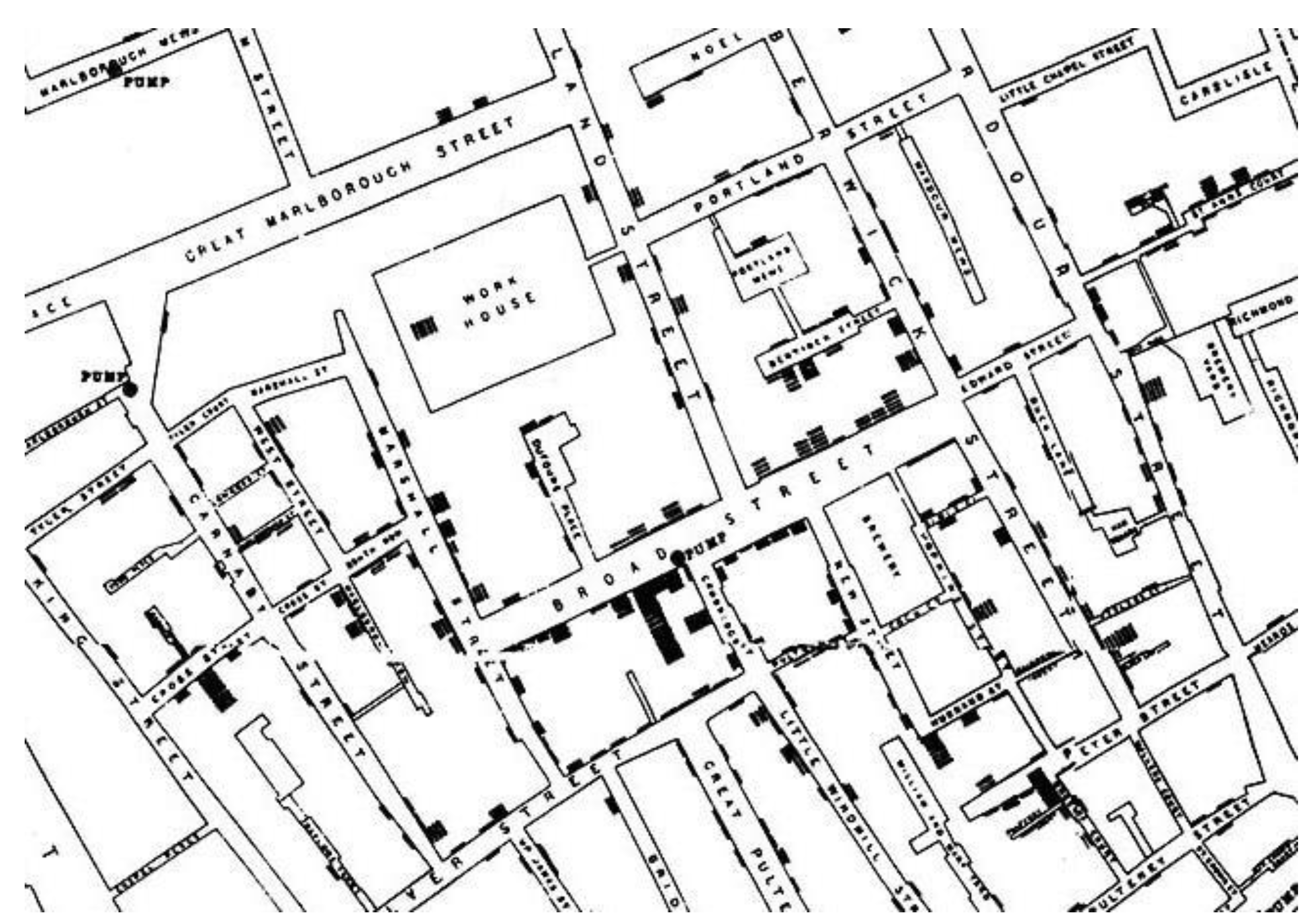
-
Heatmap: heatmaps map the concentration of a spatial phenomenon. For instance, a heatmap of car accidents [7];
-
Proximity analysis: this analysis determines the impact of a spatial feature. For instance, assessing the impact of green spaces on promoting cycling [8];
-
Spatial regression: this regression method refers to any regression technique that accounts for spatial dependency in the data. For instance, modeling cycling ridership at an intersection level by correcting for cycling ridership at a neighboring intersection [9];
-
Suitability analysis: this analysis assigns a numeric value for factors relative to their importance in order to find the optimal location for certain spatial features. For instance, finding optimal school locations to promote student walking and cycling [10];
-
Agent-based model: a type of model that evaluates the effect of certain environments on agents by simulating their actions. For instance, comparing between driving, cycling, and walking distance for simulated journeys in certain cities. Therefore, the agents are corresponding to the simulated trips, whereas the cities are the environments constrained by the street networks [11];
-
Spatial autocorrelation analysis: this analysis statistically assesses the spatial patterns of a certain variable. The returned value of this analysis ranges from 1 (postive spatial autocorrealtion) to −1 (negative spatial autocorrelation), where the value of 0 represents spatial randomness. As shown in Figure 2, spatial autocorrelation occurs when a given feature is neighbouring features with similar value; for example, a feature with high (or low) values are situted near other features with high (or low) values. As opposed to negative spatial autocorrealation, a given feature is neighbouring features with dissimilar values. For example, there is a tendency for cyclists to cycle in (or close by) areas where cycling is common due to many reasons, among which is the ‘safety-in-numbers’ theory. This theory states that, when the number of cyclists increases, drivers will pay more attention, and thus provide a safer environment [12];
-
Map matching: in order to reveal the path of vehicles/travelers, map matching techniques (e.g., Douglas and Peucker algorithms) are used to match the collected GPS points from vehicles/travelers to the corresponding street segments. For example, this technique is presented in Google Maps Platform (https://developers.google.com/maps/documentation/roads/snap, accessed on 22 March 2022) and is constantly being used in tracking apps;
-
Participatory mapping: involving the general public in spatial data collection through online platforms is known as participatory mapping. For example, the public can report bike safety issues using BikeMaps.org (http://BikeMaps.org, accessed on 22 March 2022) and walking or rolling safety issues using WalkRollMap.org (https://walkrollmap.org, accessed on 22 March 2022).

-
GPS trajectories: consecutive GPS points retrieved at a predefined time interval from the users, revealing their location. Map matching techniques are then preformed to convert these points to nearest streets. Certain smartphones apps (elaborated in Section 3) provide such data. This data are useful to estimate ridership at a street level, which is considered the finest available data;
-
Origin–destination: data of the start (origin) and the end (destination) of each journey are used. The data can be represented as points (e.g., representing a bike- sharing system station or kiosk) or aggregated to represent a city zone;
-
Self-reported journeys: research can solicit a journey’s data using participatory mapping by recruiting participants. Yet, the accuracy of the obtained data depends to a large extent on the participants’ skills of mapping [14].
3. Active Transportation
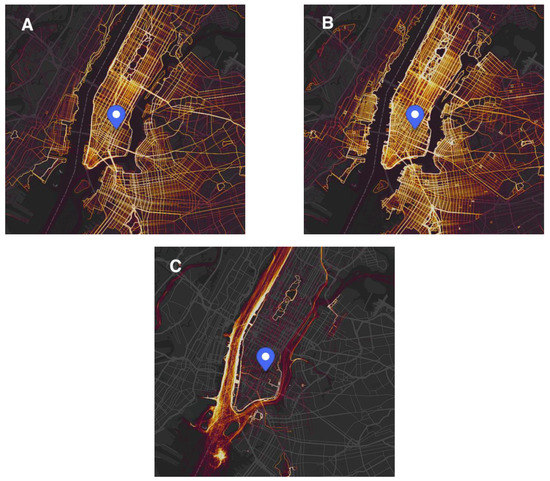
4. Micromobility
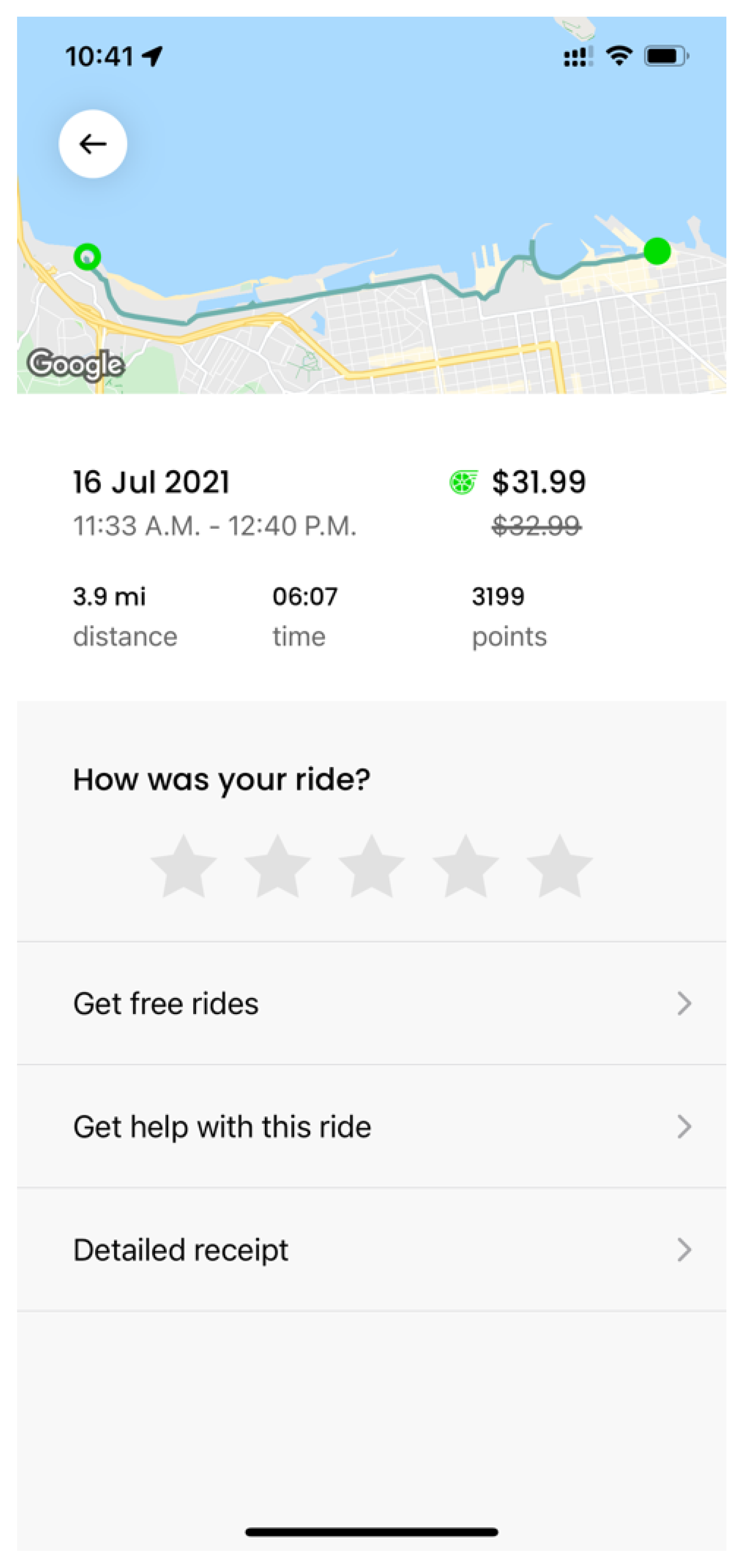
5. Cars
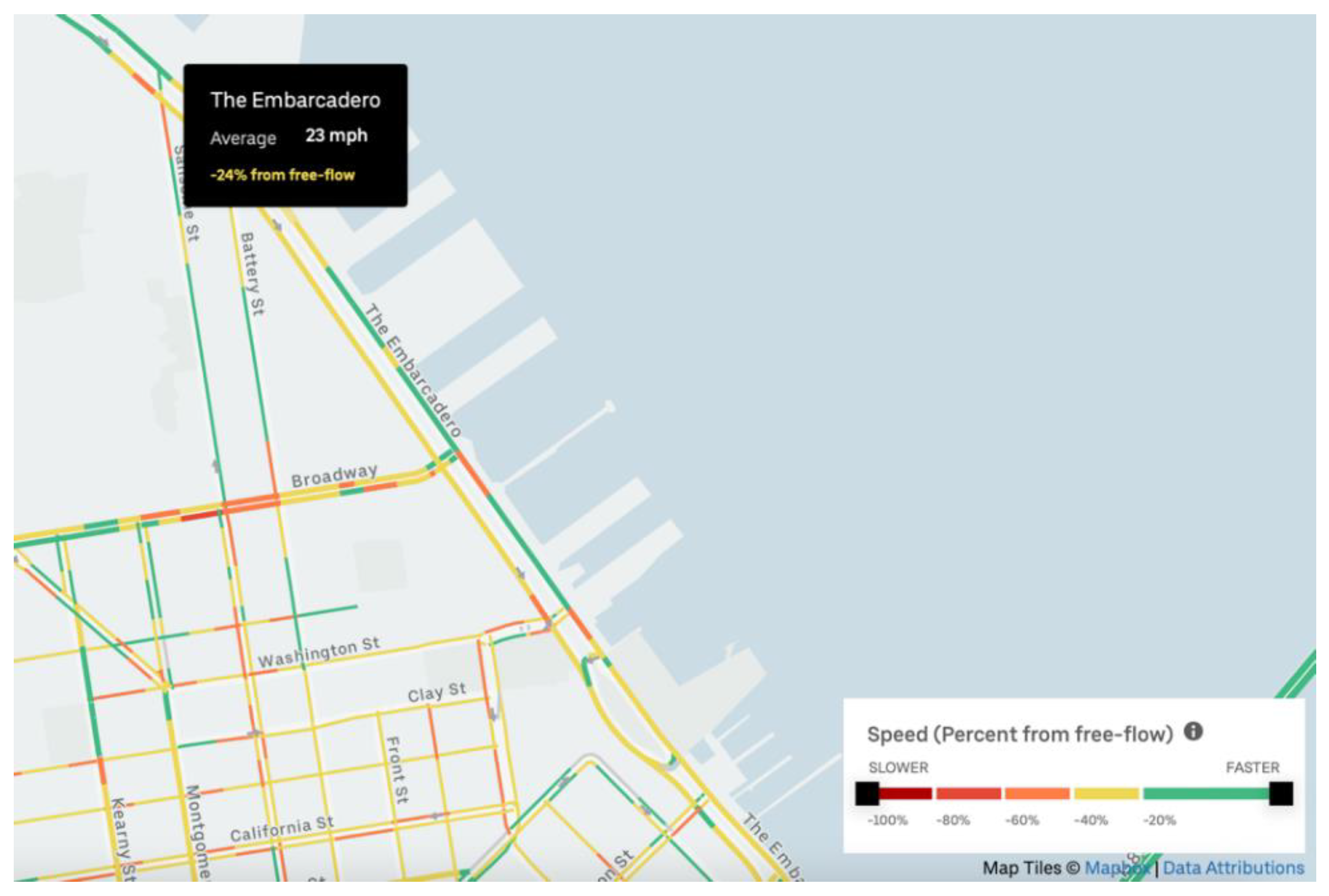
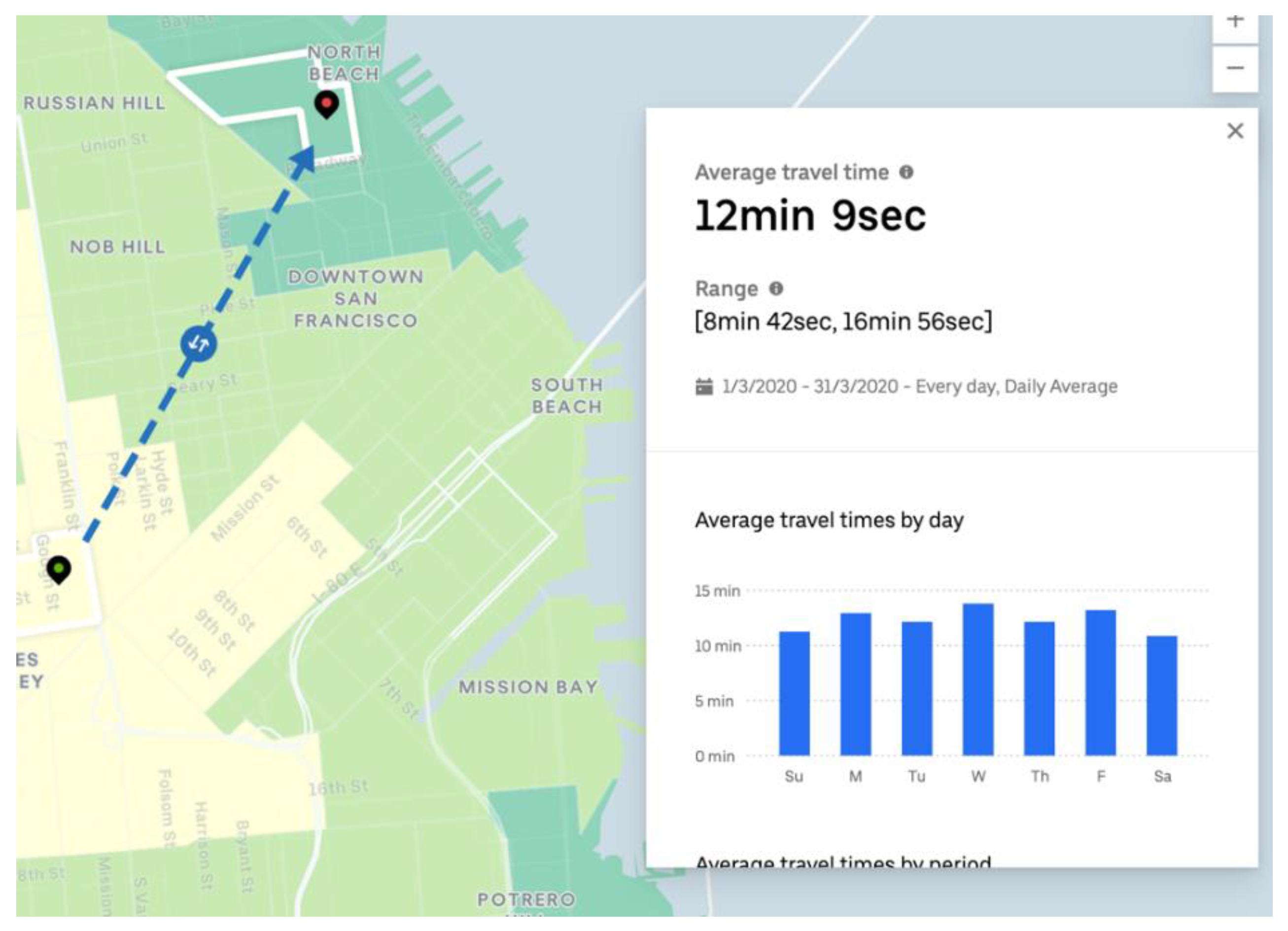
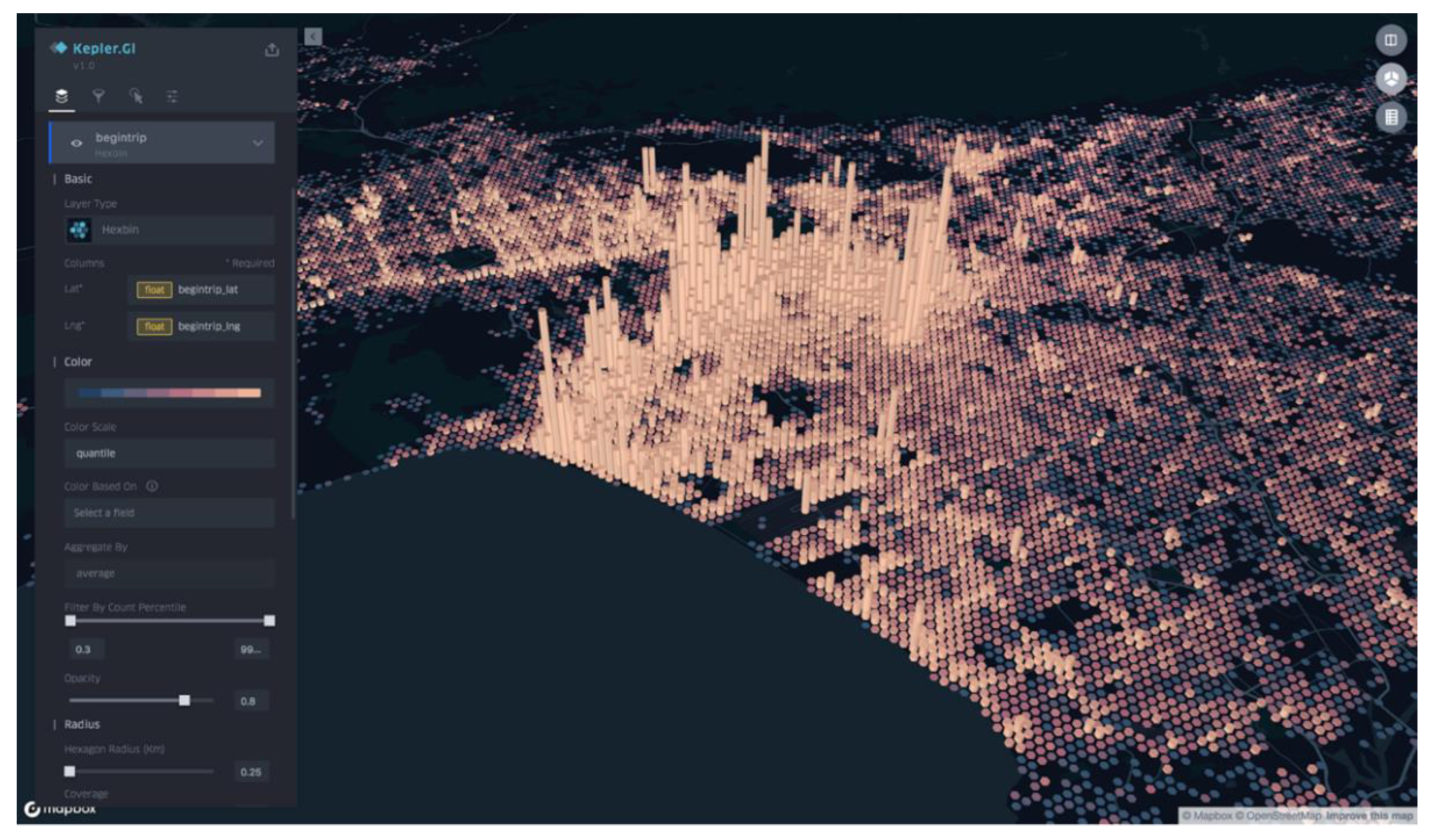
6. Concluding Remarks
| Active Transportation | Micromobility | Cars | |
|---|---|---|---|
| Data producer | Social fitness networks (e.g., Strava) Transportation agencies (e.g., SFCTA) Advocate groups (e.g., SafeLanes.org) Imagery (e.g., Google Earth) Bike-sharing systems (e.g., Los Angeles’ Metro Bike) |
Service providers (e.g., Uber Movement) Transportation agencies (e.g., City of Austin open data portal) |
Apps (e.g., Street Bump) Ride sharing services (e.g., Uber) Imagery (e.g., Google Earth) |
| Types of data | Trip volume data Trip histories data Infrastructure data |
Trip volume data | Infrastructure data Average speed and travel time |
| Methods | Spatial statistics (e.g., heatmap and proximity analysis) | Spatial statistics (e.g., heatmap and proximity analysis) | Spatial statistics (e.g., heatmap and proximity analysis) |
| Manual digitization | Manual digitization | ||
| Visualization methods | Object-oriented programing languages (e.g., R and Python) GIS software (e.g., ArcMap) Cloud-based analytic tool (e.g., Kepler.gl) |
||
-
There is a pressing need for researchers and planners to be equipped with GIS skills to deal with atomized transportation data;
-
Making the data openly available to facilitate a better understanding of trends and allowing more collaboration between researchers. A geographic gap can be witnessed in the case studies’ location, given the availability of data. For instance, limited knowledge is available about locations where active transportation is less prevalent;
-
There is a lack of studies about food delivery services making cycling more safe and providing jobs that include cyclist couriers in active transportation advocacy plans [74];
-
There is a scarcity in the literature about bike-sharing systems and micromobility vandalism and theft incidents. Collecting such data might be cumbersome for researchers. Yet, if service operators provide such data, insightful patterns that help to curb such behavior might be revealed;
-
There is a need for further investigation into the reliability of big data in terms of its representativeness and precision;
-
Replicating previous work with finer resolution data. For example, most bike-sharing system studies rely on origin–destination, whereas GPS trajectories are less used, creating a gap in the literature regarding bike-sharing system users’ route choice.
References
- Rodrigue, J.-P. The Geography of Transport Systems; Routledge: London, UK, 2020.
- Komalavalli, C.; Laroiya, C. Challenges in Big Data Analytics Techniques: A Survey. In Proceedings of the 2019 9th International Conference on Cloud Computing, Data Science & Engineering (Confluence), Noida, India, 10–11 January 2019; pp. 223–228.
- Berke, E.M. Geographic Information Systems (GIS): Recognizing the Importance of Place in Primary Care Research and Practice. J. Am. Board Fam. Med. 2010, 23, 9–12.
- Scarano, A. The Outrageous Map of the 1854 London Epidemic. Available online: https://www.domusweb.it/en/news/2020/05/03/the-outrageous-map-of-the-1854-london-epidemic.html (accessed on 11 May 2022).
- Ruankaew, N. GIS and Epidemiology. J. Med. Assoc. Thailand Chotmaihet Thangphaet 2005, 88, 1735–1738.
- van Schaaik, J.G.J.; Kemp, J.J. Real Crimes on Virtual Maps: The Application of Geography and Gis in Criminology. In Geospatial Technology and the Role of Location in Science; Springer: Berlin/Heidelberg, Germany, 2009; pp. 217–237.
- Herries, J. Mapping the Opportunity to Intervene Clearly. Available online: https://www.esri.com/about/newsroom/wp-content/uploads/2018/08/Mapping-the-Oppty-to-Intervene-Clearly.pdf (accessed on 22 March 2022).
- Campos-Sánchez, F.S.; Valenzuela-Montes, L.M.; Abarca-Álvarez, F.J. Evidence of Green Areas, Cycle Infrastructure and Attractive Destinations Working Together in Development on Urban Cycling. Sustainability 2019, 11, 4730.
- Alattar, M.A.; Cottrill, C.; Beecroft, M. Modelling Cyclists’ Route Choice Using Strava and OSMnx: A Case Study of the City of Glasgow. Transp. Res. Interdiscip. Perspect. 2021, 9, 100301.
- Stewart, N. Using Pedestrian Accessibility Indicators to Locate Schools: A Site Suitability Analysis in Greenville County, South Carolina. Doctoral Dissertation, University of Southern California, Los Angeles, CA, USA, 2016.
- Yen, Y.; Zhao, P.; Sohail, M.T. The Morphology and Circuity of Walkable, Bikeable, and Drivable Street Networks in Phnom Penh, Cambodia. Environ. Plan. B Urban Anal. City Sci. 2019, 48, 169–185.
- Alattar, M.; Cottrill, C.; Beecroft, M. Accounting for Spatial Heterogeneity Using Crowdsourced Data. Findings 2021.
- Zhu, D.; Liu, Y. Modelling Irregular Spatial Patterns Using Graph Convolutional Neural Networks. arXiv 2018, arXiv:1808.09802.
- Alattar, M.A.; Cottrill, C.; Beecroft, M. Public Participation Geographic Information System (PPGIS) as a Method for Active Travel Data Acquisition. J. Transp. Geogr. 2021, 96, 103180.
- Hern, A. Fitness Tracking App Strava Gives Away Location of Secret US Army Bases. Guardian 2018, 28, 2018.
- Saunders, L.E.; Green, J.M.; Petticrew, M.P.; Steinbach, R.; Roberts, H. What Are the Health Benefits of Active Travel? A Systematic Review of Trials and Cohort Studies. PLoS ONE 2013, 8, e69912.
- Gui, X.; Chen, Y.; Caldeira, C.; Xiao, D.; Chen, Y. When Fitness Meets Social Networks: Investigating Fitness Tracking and Social Practices on Werun. In Proceedings of the 2017 CHI Conference on Human Factors in Computing Systems, Denver, CO, USA, 6–11 May 2017; pp. 1647–1659.
- Ali, S. The Dark Side of Strava: What Happens When Users Lose Control. Available online: https://www.newstatesman.com/social-media/2021/10/thedarksideofstrava (accessed on 24 May 2022).
- Rivers, D.J. Strava as a Discursive Field of Practice: Technological Affordances and Mediated Cycling Motivations. Discourse Context Media 2020, 34, 100345.
- Ferster, C.; Nelson, T.; Laberee, K.; Winters, M. Mapping Bicycling Exposure and Safety Risk Using Strava Metro. Appl. Geogr. 2021, 127, 102388.
- Sun, Y.; Mobasheri, A. Utilizing Crowdsourced Data for Studies of Cycling and Air Pollution Exposure: A Case Study Using Strava Data. Int. J. Environ. Res. Public Health 2017, 14, 274.
- Venter, Z.S.; Barton, D.N.; Gundersen, V.; Figari, H.; Nowell, M.S. Back to Nature: Norwegians Sustain Increased Recreational Use of Urban Green Space Months after the COVID-19 Outbreak. Landsc. Urban Plan. 2021, 214, 104175.
- Jäger, H.; Schirpke, U.; Tappeiner, U. Assessing Conflicts between Winter Recreational Activities and Grouse Species. J. Environ. Manag. 2020, 276, 111194.
- Colorado Department of Transportation Strava Metro Data Analysis Summary. 2018. Available online: https://www.codot.gov/programs/bikeped/documents/strava-analysis-summary_06-25-18.pdf (accessed on 24 May 2022).
- Alkon, A.H.; Norgaard, K.M. Breaking the Food Chains: An Investigation of Food Justice Activism. Sociol. Inq. 2009, 79, 289–305.
- Hood, J.; Sall, E.; Charlton, B. A GPS-Based Bicycle Route Choice Model for San Francisco, California. Transp. Lett. 2011, 3, 63–75.
- Watkins, K.; Ammanamanchi, R.; LaMondia, J.; Le Dantec, C.A. Comparison of Smartphone-Based Cyclist GPS Data Sources. In Proceedings of the Transportation Research Board 95th Annual Meeting, Washington DC, USA, 10–14 September 2016.
- Moran, M.E. Where the Crosswalk Ends: Mapping Crosswalk Coverage via Satellite Imagery in San Francisco. Environ. Plan. B Urban Anal. City Sci. 2022, 23998083221081530.
- Zheng, L.; Li, Y. The Development, Characteristics and Impact of Bike Sharing Systems: A Literature Review. Int. Rev. Spat. Plan. Sustain. Dev. 2020, 8, 37–52.
- Hu, S.; Xiong, C.; Liu, Z.; Zhang, L. Examining Spatiotemporal Changing Patterns of Bike-Sharing Usage during COVID-19 Pandemic. J. Transp. Geogr. 2021, 91, 102997.
- El-Assi, W.; Mahmoud, M.S.; Habib, K.N. Effects of Built Environment and Weather on Bike Sharing Demand: A Station Level Analysis of Commercial Bike Sharing in Toronto. Transportation 2017, 44, 589–613.
- Ashqar, H.I.; Elhenawy, M.; Rakha, H.A. Modeling Bike Counts in a Bike-Sharing System Considering the Effect of Weather Conditions. Case Stud. Transp. Policy 2019, 7, 261–268.
- Morton, C.; Kelley, S.; Monsuur, F.; Hui, T. A Spatial Analysis of Demand Patterns on a Bicycle Sharing Scheme: Evidence from London. J. Transp. Geogr. 2021, 94, 103125.
- Li, X.; Xu, Y.; Zhang, X.; Shi, W.; Yue, Y.; Li, Q. Improving Short-Term Bike Sharing Demand Forecast through an Irregular Convolutional Neural Network. arXiv 2022, arXiv:2202.04376.
- Ma, X.; Yin, Y.; Jin, Y.; He, M.; Zhu, M. Short-Term Prediction of Bike-Sharing Demand Using Multi-Source Data: A Spatial-Temporal Graph Attentional LSTM Approach. Appl. Sci. 2022, 12, 1161.
- Teixeira, J.F.; Lopes, M. The Link between Bike Sharing and Subway Use during the COVID-19 Pandemic: The Case-Study of New York’s Citi Bike. Transp. Res. Interdiscip. Perspect. 2020, 6, 100166.
- Fung, C.M.; McArthur, D.P.; Hong, J. Examining the Effects of a Temporary Subway Closure on Cycling in Glasgow Using Bike-Sharing Data. Travel Behav. Soc. 2021, 25, 62–77.
- Korzilius, O.; Borsboom, O.; Hofman, T.; Salazar, M. Optimal Design of Electric Micromobility Vehicles. In Proceedings of the 2021 IEEE International Intelligent Transportation Systems Conference (ITSC), Indianapolis, IN, USA, 19–22 September 2021; pp. 1677–1684.
- Lazarus, J.; Pourquier, J.C.; Feng, F.; Hammel, H.; Shaheen, S. Micromobility Evolution and Expansion: Understanding How Docked and Dockless Bikesharing Models Complement and Compete—A Case Study of San Francisco. J. Transp. Geogr. 2020, 84, 102620.
- Şengül, B.; Mostofi, H. Impacts of E-Micromobility on the Sustainability of Urban Transportation—A Systematic Review. Appl. Sci. 2021, 11, 5851.
- Sundfør, H.B.; Fyhri, A. A Push for Public Health: The Effect of e-Bikes on Physical Activity Levels. BMC Public Health 2017, 17, 809.
- Schepers, P.; Wolt, K.K.; Helbich, M.; Fishman, E. Safety of E-Bikes Compared to Conventional Bicycles: What Role Does Cyclists’ Health Condition Play? J. Transp. Health 2020, 19, 100961.
- Aman, J.J.C.; Zakhem, M.; Smith-Colin, J. Towards Equity in Micromobility: Spatial Analysis of Access to Bikes and Scooters amongst Disadvantaged Populations. Sustainability 2021, 13, 11856.
- Philips, I.; Anable, J.; Chatterton, T. A Small Area Estimation of the Capability of Individuals to Replace Car Travel with Walking, Cycling and e-Bikes and Its Implications for Energy Use. In Proceedings of the ECEEE Summer Study Proceedings, Hyères France, 3–8 June 2019; pp. 1097–1104.
- Li, Y.; Dai, Z.; Zhu, L.; Liu, X. Analysis of Spatial and Temporal Characteristics of Citizens’ Mobility Based on e-Bike GPS Trajectory Data in Tengzhou City, China. Sustainability 2019, 11, 5003.
- Espinoza, W.; Howard, M.; Lane, J.; Van Hentenryck, P. Shared E-Scooters: Business, Pleasure, or Transit? arXiv 2019, arXiv:1910.05807, 5807.
- Yan, X.; Yang, W.; Zhang, X.; Xu, Y.; Bejleri, I.; Zhao, X. A Spatiotemporal Analysis of E-Scooters’ Relationships with Transit and Station-Based Bikeshare. Transp. Res. Part D Transp. Environ. 2021, 101, 103088.
- Li, A.; Zhao, P.; He, H.; Axhausen, K.W. Understanding the Variations of Micro-Mobility Behavior before and during COVID-19 Pandemic Period. Arbeitsberichte Verkehrs-und Raumplan. 2020, 1547.
- Bai, S.; Jiao, J. From Shared Micro-Mobility to Shared Responsibility: Using Crowdsourcing to Understand Dockless Vehicle Violations in Austin, Texas. J. Urban Aff. 2020, 1–13.
- Brown, A.; Klein, N.J.; Thigpen, C.; Williams, N. Impeding Access: The Frequency and Characteristics of Improper Scooter, Bike, and Car Parking. Transp. Res. Interdiscip. Perspect. 2020, 4, 100099.
- Schepers, P.; Klein Wolt, K.; Fishman, E. The Safety of E-Bikes in The Netherlands; Discussion Paper; International Transport Forum: Paris, France, 2018.
- Brisimi, T.S.; Cassandras, C.G.; Osgood, C.; Paschalidis, I.C.; Zhang, Y. Sensing and Classifying Roadway Obstacles in Smart Cities: The Street Bump System. IEEE Access 2016, 4, 1301–1312.
- Burgart, S. Gap Trap: A Pothole Detection and Reporting System Utilizing Mobile Devices. 2014. Available online: https://www.cs.umd.edu/sites/default/files/scholarly_papers/Burgart.pdf (accessed on 24 May 2022).
- Zhang, Z. Exploring the Potentials of Using Crowdsourced Waze Data in Traffic Management: Characteristics and Reliability. Doctoral Dissertations, University of Tennessee, Knoxville, TN, USA, 2020.
- Moran, M. What’s Your Angle? Analyzing Angled Parking via Satellite Imagery to Aid Bike-Network Planning. Environ. Plan. B Urban Anal. City Sci. 2020, 48, 2399808320954205.
- Dukiya, J.J. GIS Based On-Street Urban Parking Analysis and Management in Minna, Niger State, Nigeria. Int. J. Sustain. Transp. Logist. 2021, 1, 1–11.
- Pappalardo, L.; Rinzivillo, S.; Qu, Z.; Pedreschi, D.; Giannotti, F. Understanding the Patterns of Car Travel. Eur. Phys. J. Spec. Top. 2013, 215, 61–73.
- Lee, K.; Sener, I.N. Emerging Data Mining for Pedestrian and Bicyclist Monitoring: A Literature Review Report; Safety through Disruption (Safe-D) National University Transportation Center (UTC) Program; Texas A&M Transportation Institute: Austin, TX, USA, 2017.
- Sun, Y.; Ren, Y.; Sun, X. Uber Movement Data: A Proxy for Average One-Way Commuting Times by Car. ISPRS Int. J. Geo-Inf. 2020, 9, 184.
- Ch, N.A.N.; Krumm, J.; Kun, A. Speed Anomalies and Safe Departure Times from Uber Movement Data. In Proceedings of the 9th SIGKDD International Workshop on Urban Computing, San Diego, CA, USA, 24 August 2020.
- Correa, D.; Xie, K.; Ozbay, K. Exploring the Taxi and Uber Demand in New York City: An Empirical Analysis and Spatial Modeling. In Proceedings of the 96th Annual Meeting of the Transportation Research Board, Washington, DC, USA, 8–12 January 2017.
- Willis, G.; Tranos, E. Using ‘Big Data’to Understand the Impacts of Uber on Taxis in New York City. Travel Behav. Soc. 2021, 22, 94–107.
- Brodeur, A.; Nield, K. An Empirical Analysis of Taxi, Lyft and Uber Rides: Evidence from Weather Shocks in NYC. J. Econ. Behav. Organ. 2018, 152, 1–16.
- Jin, S.T.; Kong, H.; Sui, D.Z. Uber, Public Transit, and Urban Transportation Equity: A Case Study in New York City. Prof. Geogr. 2019, 71, 315–330.
- Blazquez, C.; Laurent, J.G.C.; Nazif-Munoz, J.I. Differential Impacts of Ridesharing on Alcohol-Related Crashes by Socioeconomic Municipalities: Rate of Technology Adoption Matters. BMC Public Health 2021, 21, 2008.
- Du, J.; Rakha, H.A.; Breuer, H. An In-Depth Spatiotemporal Analysis of Ride-Hailing Travel: The Chicago Case Study. Case Stud. Transp. Policy 2022, 10, 118–129.
- Marzuoli, A.; Liu, F. A Data-Driven Impact Evaluation of Hurricane Harvey from Mobile Phone Data. In Proceedings of the 2018 IEEE International Conference on Big Data (Big Data), Seattle, WA, USA, 10–13 October 2018; IEEE: New York, NY, USA, 2018; pp. 3442–3451.
- Yang, C.; Sha, D.; Liu, Q.; Li, Y.; Lan, H.; Guan, W.W.; Hu, T.; Li, Z.; Zhang, Z.; Thompson, J.H.; et al. Taking the Pulse of COVID-19: A Spatiotemporal Perspective. Int. J. Digit. Earth 2020, 13, 1186–1211.
- MacKenzie, D.; Ban, X.J.; Pathak, C.; Arabkhedri, B. Crowdsourcing Parking Data for Micromobility Vehicles; Connected Cities for Smart Mobility toward Accessible and Resilient Transportation Center: Brooklyn, NY, USA, 2020.
- Hasimoto-Beltran, R.; Calderon-Calderon, M.D.; Olavarría-Jaramillo, V.H. Secure Real-Time Chaotic Partial Encryption of Entropy-Coded Multimedia Information for Mobile Devices: Smartphones. IEEE Access 2022, 10, 15876–15890.
- Ghorbanzadeh, M.; Effati, M.; Gilanifar, M.; Ozguven, E.E. Subway Station Site Selection Using GIS-Based Multi-Criteria Decision-Making: A Case Study in a Developing Country. Comput. Res. Prog. Appl. Sci. Eng. 2020, 6, 60–69.
- Borhani, M.; Akbari, K.; Matkan, A.; Tanasan, M. A Multicriteria Optimization for Flight Route Networks in Large-Scale Airlines Using Intelligent Spatial Information. Rev. IJIMAI 2020, 6, 121–123.
- Gabe, T.M.; Lynch, C.P.; McConnon Jr, J.C. Likelihood of Cruise Ship Passenger Return to a Visited Port: The Case of Bar Harbor, Maine. J. Travel Res. 2006, 44, 281–287.
- Lee, D.J.; Ho, H.; Banks, M.; Giampieri, M.; Chen, X.; Le, D. Delivering (in) Justice: Food Delivery Cyclists in New York City. In Bicycle Justice and Urban Transformation; Routledge: London, UK, 2016; pp. 114–129.
